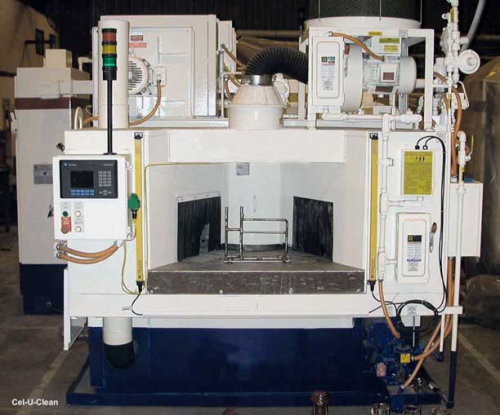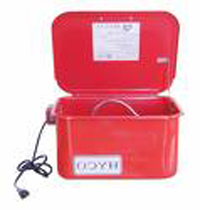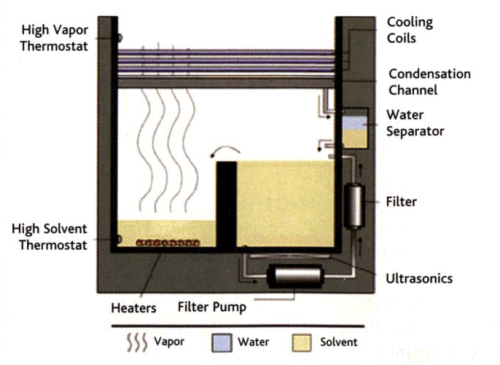


This is that parts cleaning column. It is about “cleaning times” in the early to mid-1990s during the chlorofluorocarbon (CFC) phaseout. It’s about how we got from the past to today in metal cleaning and what tomorrow might look like.
The Late 1980s
During this period, the largest-ever incidence of technical, political, commercial, and psychological disruption was imposed upon the industrial cleaning market, as well as many others.
The technical driver was environmental, based on convincing scientific evidence that use and, therefore, release of certain chemicals into the atmosphere was responsible for the long-term destruction of the Earth’s stratospheric ozone layer.
The political driver was the global response to this evidence. The Montreal Protocol, on Substances that Deplete the Ozone Layer, was signed by 24 countries on Sept. 16, 1987. As of this writing, more than 185 countries have signed it. The parties recognized that a ban on local use would be unfair, difficult to enforce, and ultimately unproductive, and ,thus, chose the more productive step of banning its manufacture. The ban is progressive, favoring “developing” countries that are given additional time to develop an infrastructure that can produce suitable alternatives to CFCs.
The commercial driver was the global phase-out of manufacture of CFC-based chemicals. Although not strictly a CFC, 1,1,1-trichloroethane (TCA) was also treated as such because of its extremely high-use volume as an ozone-depleting chemical. Use of either chemical was a dominant commercial choice, although other choices were well known.
The psychological driver was the pace (about one-half decade) and extent (complete reversal) of change to an activity whose details were settled art, for a reason not accepted by all affected.
Technology Situation
Prior to the Montreal Protocol, cleaning was primarily done with solvents: hydrocarbon-based (mineral spirits), halogenated (such as CFC-113 and TCA), and miscellaneous others. The reason for their widespread use was that these solvents were familiar, low-priced, well-matched to soils, and did not require significant process equipment. I have witnessed major companies that have done valued cleaning work with TCA using a coffee can, a paint brush, and no emission control facility. Because these solvents evaporated rapidly, parts “dried themselves” in ambient air.
Some firms were cleaning with aqueous cleaning technology that required: significant customization; substantial facilities for washing and rinsing, as well as the floor space to hold them; additional drying facilities with associated energy costs, and time for development and training; as well as facilities for management of water-soil wastes.
The marketplace was probably split 80% to 20%, respectively, for solvent versus aqueous technology. Today, the ratio is, at the very least, reversed.
Equipment Situation
Three common types of solvent cleaning equipment were:
- the aqueous rotating basket parts washer (one version is shown in Fig. 1);
- the single vessel “sink-on-a-drum” device used with hydrocarbon solvents at ambient conditions (the version shown in Fig. 2 is a “primitive” version); and
- the vapor degreaser used with boiling halogenated solvents at ambient pressure but at the solvent boiling point (see Fig. 3).
The former was highly valued by the U.S. Military for cleaning of parts and assemblies prior to repair. The hydrocarbon solvent was one of several mineral sprit mixtures, known as “PD-680.”
During this time, regional distributors attempted to solicit business from customers purchasing mineral spirits from a large national distributor by offering a surfactant-based aqueous cleaning fluid for use in “sink-on-a-drum” machines. The replacement offering included, as did that of the national distributor, fresh cleaning agent and disposal of the spent solution.
Aqueous cleaning equipment was generally used with smaller parts and consisted of multiple contact tanks and a dryer using circulation of hot forced air.
Devices for separation of liberated oil from parts (to keep parts from being reinfected) were primitive and often used mechanical scavengers made of polypropylene. Disposal of soil–water mixtures often were an afterthought.
It is crucial to note that the processes for solvent cleaning and aqueous cleaning are not similar—a point not then recognized by many users.
Psychological Situation
Suppliers considered the Montreal Protocol to be a potential financial bonanza, believing any offering would be purchased by at least some. The former turned out not to be so, at least because the cost of providing support wasn’t returned with adequate revenue.
Users of solvent cleaning technology felt deprived of something that worked well whether or not they agreed that a valid case had been made regarding the atmospheric science of ozone depletion. Some users asked why they couldn’t purchase CFC-113 or TCA without that “ozone stuff!”
All users felt that suppliers were offering inadequate products at exorbitant prices, and without knowledgeable technical support. Consultants considered it to be a “full-employment act.”
Uncertainty was commonly felt. Early in this time period, or before, the U.S. EPA announced that it would require a label of some kind on goods cleaned with ozone-depleting cleaning agents, and that label would be carried on those goods throughout their commercial life-span. To the relief of nearly all, this requirement was cancelled.
This psychological injury is still felt by many users. The users, dissatisfied with aqueous cleaning technology and its suppliers, remember the forgiveness of solvent cleaning and long for its return.
Situation Regarding Waste Disposal
A military base in California purchased a large, multi-stage aqueous cleaning system costing several million dollars and committed to use a particular cleaning agent in it, without an effective and tested plan for disposal of the spent cleaning agent. When the waste proved impractical to treat, the system was renamed the “Big Blue,” “White Elephant” and placed in the scrap area. Although expensive and career-threatening to those involved, this situation was by no means unique in my professional experience.
Consideration of waste disposal received less-than-adequate emphasis in the selection of technology, equipment, or suppliers because the focus was on cleaning of parts. As my former business partner noted, “...users would try anything that promised successful cleaning.”
Safety, Health, and Environmental Situation
It was these aspects that became dominant, led by regulatory agencies in California. They decided to preempt federal guidelines and severely restrict emissions of volatile organic chemicals (VOCs). It didn’t matter that the tonnage of emissions from cleaning operations was small compared to that emitted from large sources, such as energy and automobiles.
The net force of political pressure supported the point of view that demanded legal action, and not the reverse. Two steps of change resulted—reduction of VOC emission, followed by, essentially, an outright ban. What was striking, in my opinion, was that the cost to industry of lost manufacturing jobs was accepted by voters in California, and later, to a lesser extent, voters in other states.
The U.S. national environmental management agency, U.S. EPA, has made VOC regulation a priority. Many of the solvents specifically exempted from VOC classification are useful in cleaning work, although they are not without flaws. We now have, or will have, a manageable situation regarding smog-forming chemicals (VOCs) that limits emission both on a use exemption basis, and on the basis of relative reactivity.
More than that, in the last decade the EPA has “taken ground” from other regulatory agencies. The EPA now recommends, using existing laws, personal exposure limits for some chemicals—such as n-propyl bromide. And because regulation of emission rates has reached, or is reaching, a point of diminishing returns, future regulations will be based on additional emissions of specific chemicals and their risk to certain populations. The risk for each chemical is to be determined by epidemiological studies. This was demonstrated in the recent re-issue of the solvent degreasing National Emission Standard for Hazardous Air Pollutants (NESHAP).
Fast-Forward One Decade
The Montreal Protocol required the manufacturing phaseout of ozone-depleting chemicals such as TCA and CFC-113 by Jan. 1, 1996. Phaseout of use took longer because users had accumulated stockpiles.
Although the industrial cleaning industry does not now seek or embrace change at the pace it endured during the early 1990s, there are several substantial inventions or developments that have become commercial practice.
My industry has yet to, and maybe never will, enjoy the simplicity of cleaning, rinsing, and drying any surface with a solvent such as TCA, but at least the following have simplified or enhanced cleaning:
- removal or oil skim (water insol- ubles) from cleaning baths or tanks in an efficient and cost-effective manner;
- aqueous cleaning using custom-formulated detergent packages that replace the high-pH alkaline cleaners of the late 1980s and beyond;
- suppliers have been reduced in number by mergers, acquisitions, or failures because of shrinking margins and national (vs. regional) competition;
- purchase of any cleaning “juice” or equipment on the Internet at nationally1 competitive prices; and
- bioremediation of hydrocarbon-based soils removed from parts in a simple “sink-on-a-drum” parts washer.
Unmet Challenges
Aqueous cleaning has greatly advanced, but it is not as simple and forgiving as solvent cleaning because:
- rinsing with fluids that have a low capacity for holding soils is still space, time, and cost intensive;
- drying by evaporation is still the same, as well as energy intensive; and
- the supply of clean water is not unbounded, and may prove to be an ultimate limitation.
To summarize2 the current commercial situation, some have said about the cleaning industry to which I try to contribute that: there is little or no growth; there are no young people in the industry; products and services are all a commodity, no longer separated by technology or special features; and everything is for sale.
Notes
- For more information about how and why commerce in the cleaning sector and most other industries has changed from a local or regional basis to a national or global basis, read Tom Friedman’s excellent book, The World is Flat, Picador (2007), ISBN 0-31242507-4.
- I appreciate the contributions of Janice Baker and Arthur Gillman to this column. They are in no way responsible for misstatement of facts or presentation of opinions. I am.
Bio
John Durkee is the author of the book Management of Industrial Cleaning Technology and Processes, published by Elsevier (ISBN 0-0804-48887). He is an independent consultant specializing in metal and critical cleaning. You can contact him at PO Box 847, Hunt, TX 78024 or 122 Ridge Road West, Hunt, TX 78024; (830) 238-7610; Fax (612) 677-3170; or via e-mail.




